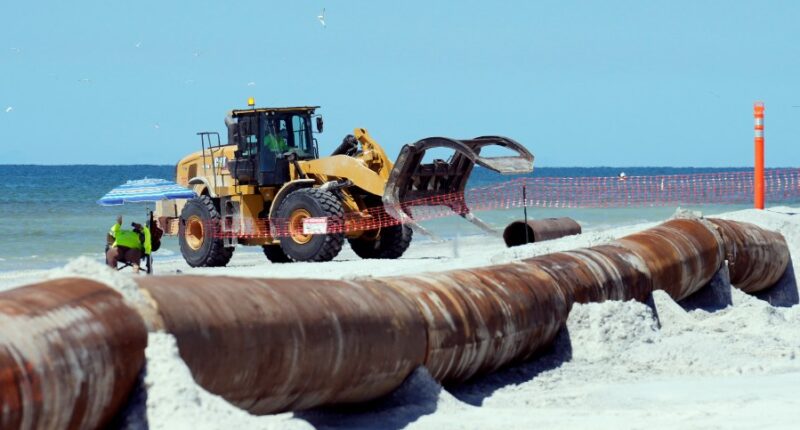Share this @internewscast.com

INDIAN ROCKS BEACH, Fla. (AP) — Last year, a stretch of Florida’s Gulf Coast was severely impacted by three hurricanes, prompting a major reconstruction effort to restore a coastline crucial to the area’s economy.
Work is underway using dredges, trucks, and pipelines along a 35-mile (56-kilometer) stretch of Pinellas County’s beaches, including tourist-favorite spots like Clearwater Beach, Indian Rocks Beach, Belleair Beach, and Redington Beach, which are still reeling from hurricanes Helene, Milton, and Debby.
Among these, Helene was particularly damaging to the coastal towns, despite its landfall occurring significantly farther north. A storm surge reaching heights of 8 feet (2.4 meters) claimed twelve lives in Pinellas County.
Historically, the U.S. Army Corps of Engineers has been instrumental in beach restoration efforts. However, this time around, they have proposed a change requiring private landowners to grant permanent easements for government access — a condition that has encountered significant opposition.
Consequently, Pinellas County is independently spearheading the beach restoration, allocating over $125 million from tourism tax funds for the initiative. Although the county has its own easement program, reluctance from some property owners to participate may result in incomplete sand restoration, leaving certain areas vulnerable to future storms.
“We can’t do it as well as we could,” expressed Barry Burton, the Pinellas County administrator. “Our aim is to apply sand to as much of the beach as possible.”
The project calls for using 2.5 million cubic yards (1.9 million cubic meters) of sand that’s being dredged and pumped from offshore. In places where property owners refused to sign the easements, new sand is being placed toward the Gulf side of the beach, which is public. The beaches are being widened by as much as 100 feet (30 meters).
For its part, the Army Corps said it can’t justify spending millions of U.S. taxpayer dollars on beach renourishment without permanent easements to allow access.
“The Corps cannot construct a project with ‘gaps’ due to missing easements,” the agency said in a statement. “The Congressionally authorized, engineered project cannot provide the level of protection when constructed with gaps.”
Those gaps mean that properties with sand dunes and an elongated beach might be next to another one with nothing — and that’s where the storm surge in future hurricanes will go.
In the past, the Army Corps paid about 65% of the beach restoration costs. Now, Pinellas County is footing the bill alone, with money that had been earmarked for a new Tampa Bay Rays baseball stadium and related development that fell through.
The team’s current ballpark, Tropicana Field, was heavily damaged in Hurricane Milton last October but is being repaired in time for next season. The Rays were sold to a new group of investors this year, and where the team will play in the future is in limbo.
The county won’t be able to afford beach work like this again, said Public Works Director Kelli Hammer Levy.
“This is the last and only time,” she said. So it’s really important that going forward, we have federal support.”

















